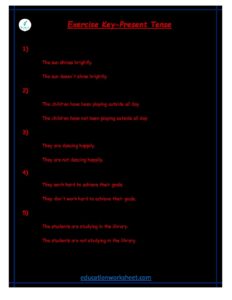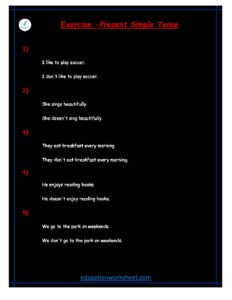changing Present Tense to negative and positive
changing Present Tense to negative and positive
Language is a dynamic and expressive tool that allows us to communicate our thoughts, feelings, and actions. One of the fundamental aspects of language is tense, which enables us to convey when an action is taking place. The present tense, in particular, is essential for describing actions that are happening right now or are habitual. However, we can add depth and variety to our communication by changing the present tense into both negative and positive forms. In this comprehensive guide, we will explore the intricacies of transforming present tense sentences, delving into the nuances and rules that govern these changes. By the end of this journey, you will have a thorough understanding of how to convert present tense sentences into negative and positive forms, enriching your language skills.
I. Transforming Present Tense into Negative:

- Introduction to Negative Present Tense:
The negative present tense allows us to express actions or situations that are not happening in the current moment or actions that are habitual but are being denied. Transforming present tense into negative involves modifying the verb form to indicate that the action is not taking place. To do this, we generally use auxiliary verbs such as “do not” or “does not” (for he, she, it) and combine them with the base form of the main verb.
- Formation of Negative Present Tense:
To convert present tense sentences into negative, follow these general rules:
a. For regular verbs (e.g., play, eat, read): – Add “do not” (don’t) before the base form of the verb for the pronouns I, you, we, they. – Add “does not” (doesn’t) before the base form of the verb for he, she, it.
b. For irregular verbs (e.g., go, have, be): – Use the appropriate form of the auxiliary verb “do not” or “does not” followed by the base form of the irregular verb.
c. Examples: – I play tennis. (Positive) – I do not play tennis. (Negative) – She eats pizza. (Positive) – She does not eat pizza. (Negative) – They go to school. (Positive) – They do not go to school. (Negative)
- Contraction in Negative Present Tense:
In informal writing and speech, contractions are commonly used in negative present tense sentences. Here are some examples:
- I don’t like broccoli. (I do not like broccoli.)
- He doesn’t understand the assignment. (He does not understand the assignment.)
- We don’t have any more ice cream. (We do not have any more ice cream.)
- Negative Present Tense for Habitual Actions:
Negative present tense can also be used to describe habitual actions that are denied. For instance:
- She doesn’t smoke.
- They don’t watch TV on weekdays.
- Negative Present Tense Questions:
When forming negative questions in the present tense, the auxiliary verb “do not” or “does not” is used at the beginning of the sentence, followed by the subject and the base form of the verb. For example:
- Don’t you like chocolate?
- Doesn’t he play the guitar?
II. Transforming Present Tense into Positive:

- Introduction to Positive Present Tense:
The positive present tense is used to describe actions that are happening right now or habitual actions that are confirmed. It is the simplest and most common form of present tense.
- Formation of Positive Present Tense:
To convert present tense sentences into positive, follow these general rules:
a. For regular verbs: – Use the base form of the verb for all pronouns.
b. For irregular verbs: – Use the appropriate form of the irregular verb.
c. Examples: – I eat breakfast. (Positive) – She swims every morning. (Positive) – They study French. (Positive)
- Positive Present Tense Questions:
When forming positive questions in the present tense, the sentence structure is slightly different from negative questions. Simply invert the subject and the base form of the verb:
- Do you like chocolate?
- Does he play the guitar?
- Positive Present Tense for Habitual Actions:
The positive present tense is often used to describe habitual actions that are confirmed or stated as facts:
- She always arrives on time.
- We visit our grandparents every summer.
- Using Adverbs with Positive Present Tense:
Adverbs can be added to positive present tense sentences to provide more information about the action. These adverbs typically describe how, when, where, or to what extent the action is happening:
- They study French diligently.
- He reads books avidly.
III. Common Mistakes to Avoid:
- Double Negatives: In English, double negatives cancel each other out, resulting in a positive meaning. Avoid using phrases like “I don’t have no money” when you mean “I don’t have any money.”
- Incorrect Verb Forms: Pay attention to verb conjugations for irregular verbs in both negative and positive forms. Mistakes like “She doesn’t went to school” should be corrected to “She doesn’t go to school.”
- Consistency: Be consistent in your use of tense within a sentence or paragraph. Avoid switching between present and past tenses without clear reason.
changing Present Tense to negative and positive

Conclusion:
In this comprehensive guide, we have explored the art of transforming present tense sentences into both negative and positive forms. By understanding the rules, practicing, and avoiding common mistakes, you can enhance your language skills and communicate more effectively. Whether you are a language learner or a native speaker, mastering these transformations will enable you to convey a wide range of ideas and thoughts with precision and clarity. Language is a powerful tool, and knowing how to wield it in various forms is an essential aspect of effective communication.
changing Present Tense to negative and positive Transforming Present Tense Verbs: Learn how to effortlessly change present tense sentences into their negative and positive forms with our comprehensive guide. Enhance your language skills today


